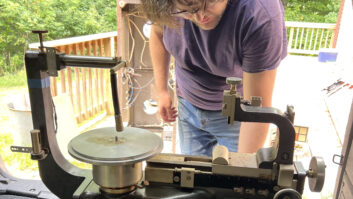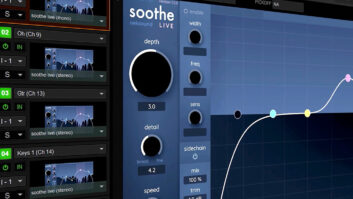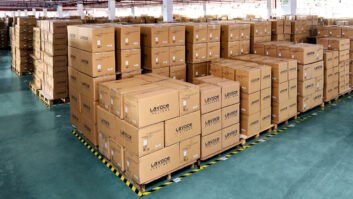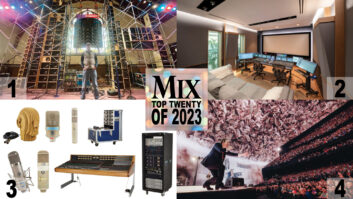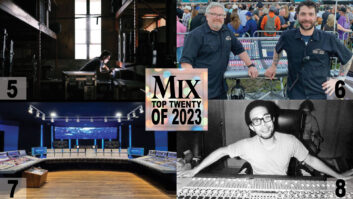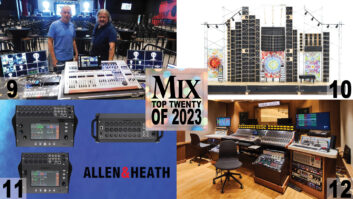As the ’60s tumbled to a close, two major concert events took place that summed up the highs and lows of the decade’s heady idealism and self-absorption. We’re talking, of course, about Woodstock and Altamont.
Woodstock permanently etched into the collective cultural conscience the idea of a blessed event where people pulled together and magic happened to the soundtrack of the greatest talent of the time; Altamont, as represented in the more chaotic moments of the movie Gimme Shelter, is a riveting snapshot of the dark side of the counterculture id run amok.
Though Altamont’s “end of the hippie era” tag may have been an overly dramatic press spin on the event, there is no denying that The Rolling Stones’ December 6, 1969, concert at Altamont Speedway in Livermore, Calif., in which a small army of out-of-control Hell’s Angels left one fan dead and countless others injured, was a tragic situation by anyone’s estimation.
Gimme Shelter, directed by Albert Maysles, David Maysles and Charlotte Zwerin and released in 1970, has just been given the DVD treatment by Criterion. Typical of other Criterion releases, it features excellent sound and picture restoration from the original film elements.
“We started by pretty much looking through the original material, and a lot of the stuff dated back to 1969 and 1970 and was pretty much a mess,” says Lee Kline, Criterion technical director. “Things were unorganized and not labeled properly. Some things didn’t have labels at all.”
When the Criterion team finally located the original 35mm mag prints, they put them up and they sounded pretty good, Kline recalls. Nevertheless, there was distortion in the upper frequencies, which was aggravating. They kept looking for better tapes, and just when they were about to give up, another box with a bunch of magnetic tracks that had no labels at all showed up. These tracks turned out to be the complete set of originals, and they sounded close to perfect.
The material was transferred to DA-88, at which point they took the tracks and cleaned them up individually within a CEDAR system. They then laid the cleaned-up tracks back to DA-88 and sent them to Pacific Ocean Post in Santa Monica, where they arranged for a 5.1 session with re-recording/remastering specialist Ted Hall. Criterion also called in the original Altamont sound person, Stanley Goldstein, to be a part of the mix.
“There was a 16-track made by Alembic Recording, but no one knows where the original 16-track is, so I was given a 4-track, which comprised guitar, left and right, on channels 1 and 3, bass drums and vocals on the center channel and an audience mic,” Hall recalls. “So they were kind of intending this to be a surround sort of project originally.
“But Stan [Goldstein] said that even if we found the 16-track, we wouldn’t want to try and deal with it. Everything was running off of generators at the show and whenever there were loud sections with the band, the power would be drained and the tape machine would slow down and the sync would slow down,” says Hall. “As it turned out, they had to varispeed all sorts of elements, just to get it in sync for the original release. It is amazing that they even got what they did.”
On first listen, Hall says, the tracks felt pretty harsh, sonically. “If you cranked it up pretty loud, it just hurt,” he says. “I smoothed it out with EQ. It is a 90-minute show, and you don’t want 90 minutes at 100 dB. I wouldn’t appreciate that for a movie. If you are going to a concert, well that is a different experience.”
ROUGH-AND-TUMBLE SOURCEThere were plenty of problems that took place during the recording of the show itself. First off, the microphones on the stage were being moved around and knocked over, and there were people jumping up on the stage.
“You can see that going on in the picture,” Hall says. “The bass would go away sometimes or a guitar. The drums would move around. It was mayhem up there with all those people running around, especially toward the end of the concert. The Stones would start a song and then stop it, and then Hell’s Angels and other people would run around on the stage. The Hell’s Angels were grabbing mics, so mics never got placed back to where they were, so the sonic image and the tonality of it changes throughout the whole concert. The only thing that remains consistent are the guitars, and they actually sound very nice.”
Hall decided that instead of making a hard, discrete center channel, he would spatialize it and create a left-center-right “drape,” which created a pseudo-stereo image off a mono center track.
“I draped it across the left-center-right, kind of like a bell shape, with the guitars filling out and using the audience tracks as the surround,” explains Hall. “Stanley, who was in the original production, wanted to try and maintain as much of the original mix as possible, so I didn’t sweeten or add anything. I just EQ’d and utilized a couple of processing things and that was it. It was pretty straightforward.”
As with many movies of the late ’60s and early ’70s, the recording was very mids heavy, so Hall backed off on that to give it a smooth quality. He didn’t use a lot of compression, but he did make use of the onboard processors and compressors on his AMS Neve Logic II digital console. In those situations where the bass would disappear in a track due to some stage problem, Hall would search for a similar sound and try to pull it out in the mix. (Editor’s Note: Hall employed the same technique in his stunning work on the effects track for Yellow Submarine. See Mix, September 2000.)
“If it was distant, away from the mic, or if there was a bar of music missing, I would take that bar from somewhere else,” Hall says. “If it was like a regular rhythm passage, where the rhythm section was playing anything different, I would steal a bar from somewhere else. Otherwise, there was no control. If you tried to crank up the bass, it just became boomy, and you would just get this loud stage tone.
“But if you are watching the movie, it is very clear what is going on,” he continues. “It was four hours before the Stones got onstage, and everybody was mad. The Hell’s Angels were extremely upset at the Stones, so as a consequence, the Stones were pretty freaked out – you could tell. Plus, you had people jumping onstage, and then the Hell’s Angels started beating up people, and there are some shots where Wyman has this stunned look on his face and he just simply stops playing.
“Every time the Stones would start `Sympathy for the Devil,’ the crowd would go nuts, and then there would be some skirmish and they would have to stop. They would start back up and it would happen again. Granted, everyone was on acid near the stage. The shots of the people are pretty amazing.”
FIRST-HAND ACCOUNTSAround the time he got the project, Hall happened to bump into folks who had been at Altamont. “The previous owner of Pacific Ocean Post said to me, `I was there.’ He was up front, but when things got a little rough, he moved about a hundred yards away. He said that it was a nightmare.
“There happened to be a Pacific Ocean Post party, and a client of mine, who I’ve known for almost 15 years, said, `I was up there. If you look at the footage, you would see me. The Hell’s Angels came through there and made everyone take acid, and everyone was cramped like sardines and it was totally disturbing. Then the Angels decided to drive through the crowd with their motorcycles and beat up people to get them out of the way.’ That put a whole different perspective on this. When I was print mastering, I was looking at it and going, `Oh my God!'”
Stan Goldstein, who recorded and mixed the original show and movie, recalls it a little differently:
“I’ve spoken to lots of people who were there, and once you got beyond a certain radius from the stage, which was not all that far, people knew that shit was going on, but they didn’t know what,” explains Goldstein. “Most of the people who were there had a nice, peaceful, quiet day in the sun and music, for which it was occasionally interrupted. You know?
“The music going on over the P.A. was so much louder than all of the chatter that may have been going on, like `Cool out’ or `Calm down’ or `Relax,'” continues Goldstein. “So the music got interrupted, and people in the back had their picnics and their sandwiches and cocktails and waited for the music to start again. All the action was in that contained, compressed jam territory up front.”
Gimme Shelter was released on DVD by Criterion and Home Vision Entertainment last November.

